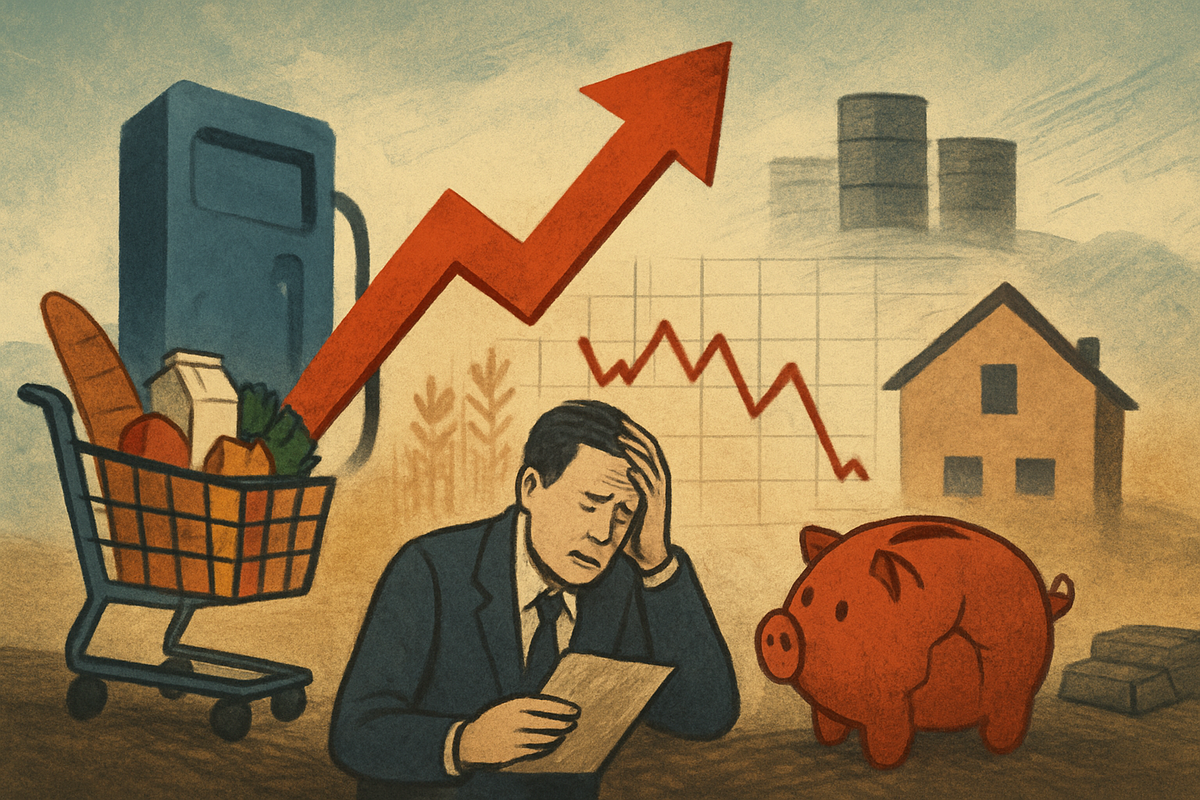
As of November 12, 2025, inflation continues to exert a significant, albeit nuanced, influence on the global economy, impacting stock markets and investor confidence. While there are some indications of moderating price pressures in certain regions, persistent challenges, particularly related to commodity prices, keep central banks on alert and maintain a cautious investment environment. The current inflationary landscape is characterized by varied trends across major global economies, with the United States seeing its annual inflation rate stand at 3.0% for the 12 months ending September 2025, remaining stubbornly above the Federal Reserve's target.
The enduring grip of inflation is creating a volatile and complex environment for stock markets worldwide. Global financial markets are reacting with heightened sensitivity to every piece of economic data, especially inflation reports and central bank announcements. This fosters a cautious sentiment among investors, leading to increased market volatility and a re-evaluation of investment strategies across asset classes. Investor and consumer confidence remain impacted by ongoing inflationary pressures and economic uncertainties, prompting a cautious sentiment and leading consumers to express worries about potential negative economic consequences.
The Unyielding March of Prices: A Deep Dive into Current Inflationary Dynamics
As of November 12, 2025, the global inflationary environment is characterized by persistent, albeit moderating, price pressures, influenced by a complex interplay of geopolitical tensions, evolving monetary policies, and shifting trade dynamics. While global inflation had significantly cooled from its 2022 peak, several factors suggest a nuanced and potentially volatile outlook for the remainder of 2025 and into 2026.
For the United States, recent data and "nowcasts" indicate that inflation continues to trend above the Federal Reserve's 2% target. The Consumer Price Index (CPI) in September 2025 was reported at 3.0%, a slight increase from 2.9% in August 2025. The annual core inflation, which excludes volatile food and energy prices, stood at 3.0% in September 2025, down from 3.1% in August. Nowcasts for November 2025 suggest a year-over-year CPI of 2.97% and core CPI of 2.95%. Globally, inflation is projected to decline steadily from 6.8% in 2023 to 4.5% in 2025, though the International Monetary Fund (IMF) notes that services inflation is holding up disinflation, complicating monetary policy normalization.
The current inflationary environment is the culmination of several key developments. Following a post-pandemic surge that peaked at nearly 9% in late 2022, global CPI inflation approximately halved by late 2024 as supply chains normalized. This period also saw aggressive interest rate hikes by major central banks. However, a pivot towards monetary easing began in late 2024 and early 2025, with the European Central Bank (ECB) leading the way with several rate cuts by mid-November 2025. The year 2025 has also seen a resurgence of trade protectionism and geopolitical tensions, with renewed threats of higher tariffs on U.S. imports and potential conflicts posing significant upside risks to global inflation. In the U.S., a government shutdown on October 1, 2025, added to economic uncertainty, while the Federal Reserve cut rates in late October 2025 by 25 basis points, bringing the benchmark short-term interest rate target to 3.75%–4%.
Key players and stakeholders involved in this inflationary saga include central banks such as the U.S. Federal Reserve, the European Central Bank, the Bank of England, and the Bank of Japan, all navigating varying degrees of inflation and economic growth. Governments, particularly in the U.S. with a new presidential administration, play a crucial role through fiscal policy and trade decisions, with the threat of new tariffs being a significant factor. Consumers continue to face elevated prices, and labor shortages in various sectors contribute to higher wages, which can, in turn, increase consumer prices. Businesses and industries are contending with supply chain challenges, rising energy costs, and labor market dynamics, prompting vigilance in pricing adjustments. Despite these prevailing uncertainties, market reactions have been mixed, with equity markets showing resilience in some areas (e.g., AI-related spending) but also experiencing broad retreats due to persistent inflation fears and geopolitical tensions.
Corporate Fortunes in Flux: Winners and Losers in an Inflationary Economy
Persistent inflation, as observed in November 2025, acts as a powerful differentiator in the corporate landscape, creating clear winners and losers. Companies with inherent pricing power, those dealing in essential goods, and sectors benefiting from higher interest rates tend to thrive, while others struggle with squeezed margins and reduced consumer demand.
On the winning side, Financials are a prime example. Banks like Capital One (NYSE: COF), Ally Financial (NYSE: ALLY), and PNC Financial (NYSE: PNC) benefit significantly from higher interest rates, which boost their net interest margins from lending activities. Insurance companies such as Prudential Financial (NYSE: PRU) and Metlife (NYSE: MET) also see increased interest revenue from their fixed-income portfolios. Consumer Staples companies, offering essential goods, possess strong brand equity that allows them to pass on rising input costs. Coca-Cola (NYSE: KO) and Procter & Gamble (NYSE: PG) are classic examples of firms that can maintain profit margins through price increases. Energy and Commodities producers are also typically well-positioned, as demand for resources like oil and gas often remains stable or even increases during inflationary periods, enabling them to raise prices. Industrials and Utilities can often pass on increased costs due to the essential nature of their services, while companies with strong pricing power or near-monopolies, such as ASML in the semiconductor industry or Visa (NYSE: V) with its frictionless fee pass-through, can effectively protect their profitability. Even Defense Stocks like Northrop Grumman (NYSE: NOC) and Lockheed Martin (NYSE: LMT) can see a tailwind from increased government spending.
Conversely, companies sensitive to borrowing costs or reliant on discretionary consumer spending face significant headwinds. Real Estate Investment Trusts (REITs) and other highly leveraged businesses are vulnerable to higher borrowing and refinancing costs, directly impacting their earnings. Discretionary Consumer Goods and Retailers, especially those selling non-essential items, suffer as inflation erodes purchasing power. Companies like Party City have cited inflation as a reason for closures, and even established brands like Kraft Heinz have seen organic net sales decrease as consumers switch to lower-priced alternatives. Fast-food and casual dining restaurants, including Bloomin' Brands (NASDAQ: BLMN), report decreased operating margins due to higher commodity and labor costs. Automobile, RV, and Boat Sales experience lagged negative effects from higher interest rates, making large purchases more expensive. Growth Stocks, particularly in tech with high valuations, are more negatively impacted as higher interest rates discount their future cash flows more heavily. While some tech giants like Nvidia (NASDAQ: NVDA) and Microsoft (NASDAQ: MSFT) have seen significant growth in certain areas, the broader tech sector can experience drops due to valuation concerns and rising costs. Finally, businesses with high input costs and limited pricing power, such as those in hospitality and manufacturing, face profit margin compression.
Beyond the Balance Sheet: The Broader Implications of Enduring Inflation
The persistent inflationary environment of November 2025 extends far beyond individual corporate balance sheets, weaving its way into broader industry trends, creating ripple effects across competitive landscapes, and prompting significant regulatory and policy considerations. This period also draws striking parallels to historical inflationary episodes, offering valuable lessons for the path ahead.
This enduring inflation is fundamentally reshaping industry trends. Sectors with strong pricing power, such as Utilities, Energy, and Industrials, are demonstrating resilience, capable of passing increased costs onto consumers. Conversely, industries with thin profit margins or high import dependencies, particularly discretionary consumer sectors, are struggling as household budgets are squeezed. A significant trend is the shift away from hyper-globalization towards a more fragmented and regionalized economic landscape. This is evidenced by rising trade protectionism and new tariffs, compelling companies to re-evaluate and restructure global supply chains through "reshoring" or "friendshoring" efforts to mitigate risks, albeit often at higher costs. Businesses across all sectors are contending with escalating input costs for materials, transportation, and utilities, alongside rising wage expectations driven by tight labor markets, further fueling services inflation.
The ripple effects on competitors and partners are profound. Companies with strong pricing power gain a distinct competitive advantage, while those unable to absorb or pass on increased costs risk losing market share and profitability. Inflation silently erodes profit margins and diminishes the real value of cash reserves, forcing businesses to rethink capital allocation and investment strategies. The move towards regionalized supply chains means companies are re-evaluating long-standing partnerships, favoring those in geopolitically aligned or domestic regions to enhance resilience and reduce tariff risks. Higher borrowing costs, a direct consequence of central bank actions to combat inflation, can deter investment and innovation for some businesses, while agile competitors might find opportunities to streamline operations and invest in efficiency-enhancing technologies.
Regulatory and policy implications are at the forefront of global economic discussions. Central banks face a delicate balancing act: maintaining higher interest rates to tame inflation while being mindful of weakening labor markets and the risk of stifling economic growth. Notably, the Federal Reserve cut rates in September and October 2025, lowering the federal funds rate to 3.75%-4.00%, a complex decision amid ongoing inflation, reflecting the difficulty of its dual mandate. The Bank of England (BoE) maintained its Bank Rate at 4% in November 2025, signaling a potential December cut if disinflationary progress continues, while the European Central Bank (ECB) kept rates unchanged. Governments are also under pressure to address the cost-of-living crisis through fiscal interventions, but such measures, if not carefully managed, could exacerbate inflationary pressures. Trade policies, particularly the increasing use of tariffs, are a significant tool that can both protect domestic industries and fuel inflation by increasing import costs, contributing to global trade fragmentation.
Historically, the current period of persistent inflation often draws comparisons to the "Great Inflation" of the mid-1960s to early 1980s. That era was marked by persistently high and rising inflation, driven by expansionary monetary and fiscal policies and significant supply shocks. A key lesson from this period is the persistence of inflation and the danger of premature policy loosening. Countries that successfully resolved inflation through decisive and sustained monetary tightening, as seen under Paul Volcker in the late 1970s and early 1980s, ultimately achieved higher growth and lower unemployment in the medium to long term. This historical precedent underscores the critical trade-off between short-term economic pain and long-term price stability, and the lasting impact high inflation can have on consumer behavior and expectations across generations.
Navigating the Future: Pathways and Pivots in an Inflationary Landscape
As of November 12, 2025, the path forward for inflation and the global economy is marked by both persistent challenges and emerging opportunities, demanding strategic pivots from businesses and investors alike. The short-term outlook suggests a continuation of "sticky" price pressures, while the long-term trajectory will be shaped by policy decisions, geopolitical events, and adaptive economic behaviors.
In the short term, the United States is anticipated to see CPI average around 2.7% for 2025, with core inflation stubbornly hovering near 3%. Daily "nowcasts" for November 2025 show year-over-year CPI at 2.97% and core CPI at 2.95%, with further acceleration expected in Q4 due to factors like new tariffs. Globally, the International Monetary Fund (IMF) projects headline inflation to fall to 4.4% in 2025 and 3.7% in 2026, still above the 2% targets of many major economies. Central banks, including the Federal Reserve, are expected to continue a cautious approach, with some forecasts suggesting further rate cuts in 2025, while others predict rates will remain "higher for longer" due to persistent overshoot. The long-term possibilities range from a gradual return to moderate inflation with steady growth, supported by cautious monetary policy, to a "higher for longer" scenario driven by persistent services inflation and geopolitical factors, or even a re-acceleration due to significant fiscal stimulus or new economic shocks. A "K-shaped" economic divergence, where certain sectors and high-income groups thrive while others struggle, also remains a potential outcome.
For businesses, strategic pivots are essential. Companies must continuously reassess pricing and margins, opting for gradual adjustments while emphasizing value. Diversifying suppliers and optimizing supply chains through reshoring or nearshoring is crucial for resilience. Investing in efficiency and automation can mitigate rising labor costs. Strengthening cash flow management, securing long-term vendor agreements, and embracing holistic forecasting models are vital for navigating uncertainty. For investors, adaptations involve increasing allocations to inflation-hedged assets like Treasury Inflation-Protected Securities (TIPS), commodities, and real assets (e.g., real estate, infrastructure). Focusing on equities with strong pricing power in sectors like consumer staples, utilities, and healthcare is also advised. Reducing exposure to long-duration bonds and maintaining a diversified portfolio, potentially including international equities, are key strategies.
Market opportunities and challenges will emerge from this dynamic environment. Challenges include increased market volatility, squeezed corporate profits for businesses without strong pricing power, and a re-evaluation of risk across asset classes. Geopolitical instability and rising trade barriers will continue to add uncertainty and cost. However, opportunities exist in sectors with strong pricing power, real assets, and commodities. Innovation and technology, particularly investments in AI solutions and automation, can boost productivity and profit margins. Selective opportunities in fixed income, such as short-term bonds and long real rate positions, may also offer value.
The Unfolding Narrative: A Summary and Forward Look for Investors
As of November 12, 2025, inflation's enduring grip remains a defining characteristic of the global financial landscape. The journey through this period has underscored the stubborn nature of price pressures, the complex tightrope walk faced by central banks, and the tangible erosion of purchasing power for consumers. This era has irrevocably redefined the investment landscape, demanding a more adaptive and informed approach from all market participants.
The market moving forward will likely continue to be characterized by heightened sensitivity to economic data and central bank pronouncements. Equity markets will favor companies demonstrating robust pricing power and resilience against rising input costs, potentially leading to continued outperformance of value stocks and certain international equities. The fixed-income market will remain largely dictated by central bank policy, with TIPS continuing to offer a critical hedge against inflation. Commodities and real assets are expected to maintain their role as strong inflation hedges, providing diversification and potential capital appreciation. Currency markets may experience increased volatility as central banks pursue divergent monetary policies in response to their unique inflationary challenges.
The lasting impact of this period of persistent inflation could include structural adjustments in global supply chains, a continued focus on productivity growth through automation and AI, and a re-evaluation of the interplay between fiscal and monetary policies. The economic uncertainty fostered by high and volatile inflation may lead to lower capital investment and slower long-term economic growth, while potentially redistributing wealth from savers to borrowers and asset owners.
For investors, vigilance is paramount in the coming months. Closely monitor key inflation data, including CPI, core CPI, PPI, PCE, and the Employment Cost Index (ECI), for signs of sustained moderation or re-acceleration. Pay keen attention to central bank communications regarding interest rate decisions and forward guidance, as these will be critical market movers. Labor market reports, particularly wage growth figures, will offer vital insights into underlying inflationary pressures. Furthermore, geopolitical developments and their potential impact on commodity markets and global supply chains should be closely watched. Finally, consumer spending and business confidence indicators will provide crucial insights into aggregate demand and overall economic resilience. In this complex and evolving environment, diversification, a focus on real returns, and a proactive approach to risk management will be essential for safeguarding and growing wealth.
This content is intended for informational purposes only and is not financial advice






